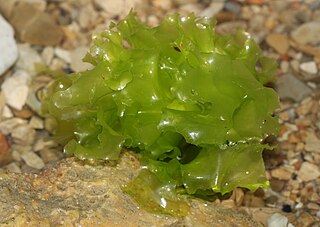Related Research Articles

The sea lettuces comprise the genus Ulva, a group of edible green algae that is widely distributed along the coasts of the world's oceans. The type species within the genus Ulva is Ulva lactuca, lactuca being Latin for "lettuce". The genus also includes the species previously classified under the genus Enteromorpha, the former members of which are known under the common name green nori.

Green laver, known as aonori in Japan, sea cabbage (海白菜) or hutai (滸苔) in China, and parae (파래) in Korean, is a type of edible green seaweed, including species from the genera Monostroma and Ulva. It is commercially cultivated in some bay areas in Japan, Korea, and Taiwan, such as Ise Bay. It is rich in minerals such as calcium, magnesium, lithium, vitamins, and amino acids such as methionine. It is also called aosa in some places in Japan.
Pseudoalteromonas ulvae is a marine bacterium isolated from the alga Ulva lactuca at the intertidal zone near Sydney.
Arenibacter certesii is a heterotrophic and aerobic bacterium from the genus of Arenibacter which has been isolated from the green alga Ulva fenestrata from the Sea of Japan.
Arenibacter palladensis is a heterotrophic and aerobic bacterium from the genus Arenibacter which has been isolated from the green alga Ulva fenestrata in the Sea of Japan.
Roseivirga ehrenbergii is a Gram-negative, heterotrophic, strictly aerobic and non-motile bacterium from the genus of Roseivirga which has been isolated from the green alga Ulva fenestrata from the Sea of Japan.
Ornithinimicrobium algicola is a Gram-positive and non-spore-forming bacterium species from the genus Ornithinimicrobium which has been isolated from the green Ulva.
Amylibacter is a genus of bacteria from the family of Rhodobacteraceae.
Amylibacter ulvae is a Gram-negative, strictly aerobic, rod-shaped and non-motile bacterium from the genus of Amylibacter which has been isolated from the alga Ulva fenestrata.
Epibacterium is a genus of bacteria from the family of Rhodobacteraceae.
Epibacterium ulvae is a Gram-negative, rod-shaped and motile bacterium from the genus of Epibacterium. It has been isolated from the alga Ulva australis from Clovelly in Australia.
Rubripirellula is a genus of bacteria from the family of Planctomycetaceae with five known species. Rubripirellula obstinata has been isolated from the alga Laminaria from the northern coast from Porto in Portugal.
Roseimaritima is a genus of bacteria from the family of Planctomycetaceae with three known species. Roseimaritima ulvae has been isolated from an Ulva from Carreço in Portugal.

Ulva australis, the southern sea lettuce, is a species of bright green coloured seaweed in the family Ulvaceae that can be found in waters around Australia and was first described by Swedish botanist Johan Erhard Areschoug. It is an edible green algae, although sometimes designated as a seaweed. General characteristics of Ulva australis include a smooth surface, distromatic blades, lobed fronds, and thallus color from dark green to light grass green. It can be either free floating or attached by a single holdfast. Its cells appear to be irregularly arranged, have rounded edges, and have shapes such as rectilinear, square, and pentagonal.
Kordia ulvae is a Gram-negative, aerobic and rod-shaped bacterium from the genus Kordia which has been isolated from the alga Ulva.
Ulvibacter litoralis is a Gram-negative, aerobic, heterotrophic and non-motile bacterium from the genus of Ulvibacter which has been isolated from the alga Ulva fenestrata.
Winogradskyella ulvae is a Gram-negative, facultatively anaerobic, slightly halophilic and motile bacterium from the genus Winogradskyella which has been isolated from the alga Ulva fenestrata.
Olleya algicola is a Gram-negative, strictly aerobic, rod-shaped and motile bacterium from the genus of Olleya which has been isolated from the alga Ulva fenestrata from the Pacific.
Pseudozobellia is a Gram-negative and aerobic genus of bacteria from the family of Flavobacteriaceae with one known species. Pseudozobellia thermophila has been isolated from the alga Ulva fenestrata.
Ulvibacterium is a Gram-negative, aerobic, rod-shaped and non-motile genus of bacteria from the family of Flavobacteriaceae with one known species. Ulvibacterium marinum has been isolated from the alga Ulva prolifera.
References
- 1 2 3 "Genus: Algitalea". lpsn.dsmz.de.
- 1 2 Yoon, Jaewoo; Adachi, Kyoko; Kasai, Hiroaki (August 2015). "Isolation and characterization of a novel marine Bacteroidetes as Algitalea ulvae gen. nov., sp. nov., isolated from the green alga Ulva pertusa". Antonie van Leeuwenhoek. 108 (2): 505–513. doi:10.1007/s10482-015-0504-5.